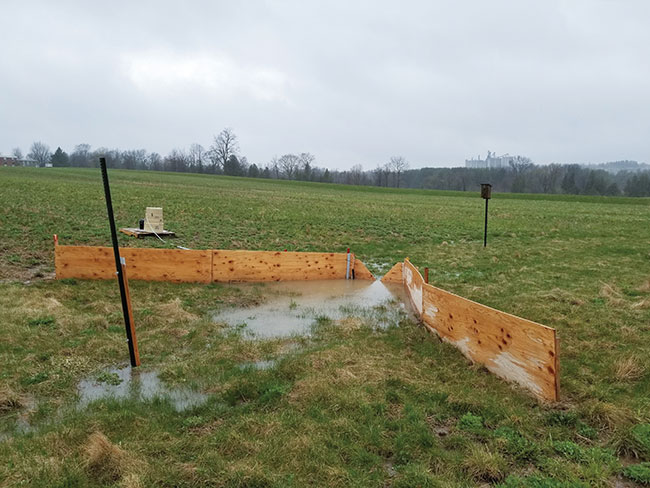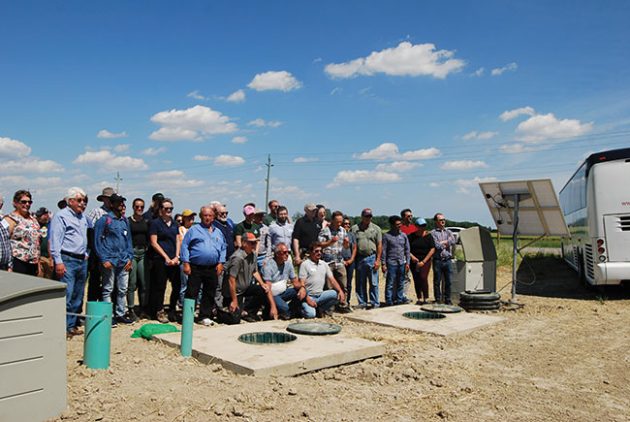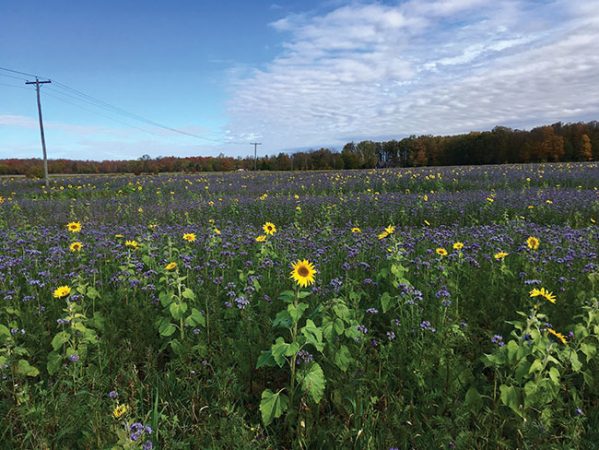
Features
Environment
What we know about winter runoff
Research finds link between agricultural phosphorus runoff and soil type.
November 9, 2020 By Robyn Roste
 Surface water quality and quantity monitoring project at Huronview Demonstration Farm near Clinton, ON. Photo courtesy of Ausable Bayfield Conservation Authority.
Surface water quality and quantity monitoring project at Huronview Demonstration Farm near Clinton, ON. Photo courtesy of Ausable Bayfield Conservation Authority. Researchers at the University of Waterloo are studying phosphorus and tile drainage in agriculture, and which best practices are most effective for managing surface and subsurface runoff.
Phosphorus is necessary for both plant nutrition and profitable production. However, when the phosphorus particles are carried off the field and into watersheds, it may cause algae blooms, which can eventually harm fish and other aquatic organisms. Therefore, managing phosphorus runoff is essential for environmental protection.
For the past decade, University of Waterloo researchers like Merrin Macrae, a professor with a PhD in hydrology and biogeochemistry, have conducted research on the effects of agricultural fertilizer management on subsurface phosphorus loss in southern Ontario.
“Our research started by looking at where the water and phosphorus were leaving the field and when, and we looked at it in different watersheds,” Macrae says. Their research spanned Ontario, including the Grand River, Thames, Essex and Chatham, and is now expanded into Manitoba.
The University of Waterloo study focuses on the non-growing months, when the greatest amount of water is running off the field due to snowmelt and heavy rain events. The research findings are showing a higher amount of phosphorus runoff in wintertime, through both surface runoff and tile drains.
The research findings are showing a higher amount of phosphorus runoff in wintertime, through both surface runoff and tile drains.
“In Ontario we have over three million acres of land that is tile drained, and we also have hundreds and thousands of municipal drains — ditch systems that go through the entire countryside that creates outlets for the tile drainage system,” explains Charlie Lalonde, project manager for the Thames River Phosphorus Reduction Collaborative (TRPRC). These drainage ditch systems deliver water to different rivers, as well as the Great Lakes.

The Thames River PRC hosted a tour of Louis Roesch’s farm in Chatham-Kent, ON, where the organization was testing a commercial product that absorbs phosphorus from tile water at the edge of a field. Photo courtesy of Thames River PRC.
Macrae’s project looks at what can be done to reduce the impact of phosphorus runoff and is accomplished through experimental and observational work. The results will help determine which management practice is the best at reducing the total amount of phosphorus for the tiles.
Lalonde says the driver to reduce phosphorus runoff is the agreement between Canada and the United States to address phosphorus in Lake Erie, with a target of reducing phosphorus levels by 40 percent.
The TRPRC looks at water management and filtration, as well as edge of field drainage solutions. Lalonde says the challenge is southern Ontario is rich in agriculture production so there are many pathways for phosphorus to enter the watershed, through drainage and erosion. He adds that the phosphorus that infiltrates tile drains through macro pores, caused by root growth or worm channels, tends to be diluted or dissolved.
“It’s mostly particulate phosphorus that attaches to soil particles, and in priority of watersheds we have to reduce the dissolved phosphorus by 40 percent as well,” Lalonde says. The Collaborative’s approach is to look at different best management practices for reducing phosphorus loss from agricultural lands.
Research is showing soil type plays a role in phosphorus loss, but there are also other contributing factors. Even the same types of soil have different levels of phosphorus loss due to environmental and physical features like soil texture, slope and climate.
“We found different results depending on where we were,” Macrae says. “Tile drains are important pathways for water and for phosphorus but in some places like in the clay, like at the southwestern end of Lake Erie, they’re the dominant phosphorus pathway. Once you’re into sloped, loamy soil then surface runoff is the more dominant pathway for phosphorus runoff.”
“Tile drains are important pathways for water and for phosphorus but in some places like in the clay, like at the southwestern end of Lake Erie, they’re the dominant phosphorus pathway. Once you’re into sloped, loamy soil then surface runoff is the more dominant pathway for phosphorus runoff.”
Colin Little works with Lower Thames Conservation and is involved with many pilot projects intended to reduce phosphorus runoff.
“We’re helping producers access ways to improve soil health and to reduce phosphorus loads,” he says. “It’s very dynamic and complex.”
With a focus on edge-of-field solutions and best management practices, these initiatives include nutrient management planning, creating detailed fertility plans, applying efficiently, grid and zone soil sampling and more.

The use of a mixed cover crop soil to improve soil health on an Ontario farm. Photo courtesy of Gerard Cornelis farms.
Most best management practices recommended for limiting surface runoff and nutrient loss are farmer-implemented, but drainage contractors still have an important role to play in managing subsurface runoff.
Ross Wilson, water and soils resources coordinator for Ausable Bayfield Conservation, says it’s important for drainage contractors to help mitigate how phosphorus enters tile drains and collaborate with farmers to understand all known problems before starting work.
“Drainage contractors have the experience, doing thousands of acres per year, so they can help figure out problem points and come up with suggestions and address the issues. Maybe it’s a case of when we put in water and sediment control basins,” Wilson says. “The contractor as he designs the system needs to be aware of all the farmer’s needs so he creates an effective design. Good communication is so important.”
Wilson says the best management practice (BMP) changes for each field.
“It’s very difficult to apply a broad BMP successfully,” he says. “Some are better than others. For example, cover crops benefit many aspects. We’ve also found not all fields or even parts of the field are each contributing to water quality impairment — not even equal erosion across a field. So the BMPs that need to fix that spot might not be applied on the entire field but just a spot.”
“For example, cover crops benefit many aspects. We’ve also found not all fields or even parts of the field are each contributing to water quality impairment — not even equal erosion across a field. So the BMPs that need to fix that spot might not be applied on the entire field but just a spot.”
Macrae says there’s no one technique that will solve the phosphorus drainage issue, so she recommends the 4Rs to start. This framework incorporates using the right fertilizer source, at the right rate, at the right time and in the right place. The exact recipe for managing phosphorus loss according to the 4Rs must be customized for each field.
“It just means there’s no one-size-fits-all answer for the contribution of tile drainage to the phosphorus story, but also whether or not different practices can improve water quality or make it worse. We have to think about the landscape that the field is in,” Macrae explains.
The 4R Nutrient Stewardship is part of a number of strategies adopted in Ontario aiming to reduce the amount of nutrients lost from agricultural lands.
“We estimate that we lose half a pound of phosphorus per acre per year — that’s not a lot of phosphorus,” Lalonde with TRPRC says. “Our challenge was to see and understand the problem, and the work Merrin [Macrae] does is critical for this. As the Collaborative we were looking to evaluate potential solutions that can be scaled up on the side of agricultural fields to see if they work.”
The Thames River PRC is currently testing seven or eight different approaches, looking for ways to intercept tile water at scale, and then measure if the adequate amount of phosphorus has been removed.
“There’s no silver bullet for what exactly to do,” Macrae says. “How much you should apply, where and when you should apply, it depends on your individual circumstances. Basically, you need to find the right combination to manage phosphorus on the surface and the subsurface.”
Print this page